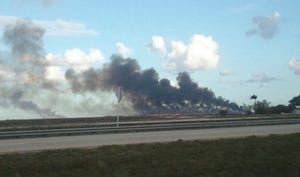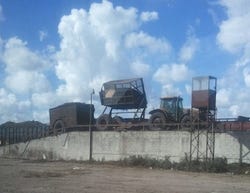April 16, 2012

Sometimes I make a mental note and file it away for future use. You never know when it may come in handy in the future. Now that I'm smartphone-equipped, I tend to text or email stuff to myself so that I have a record of it.
As we made our way to the Florida Keys last year for our honeymoon, Sherill and I saw some equipment running in the fields nearby. Farm guy that I am, I had to stop and see what they were doing. It would have been rude of me not to stop and observe my dirt brethren.
The machines and the crop they were harvesting were not familiar to me. Well, the tractors were, but that was about it. The rest of the hardware turned out to be sugar cane harvesting equipment. It looked to be good-sized, but the equipment didn’t have enormous heads to harvest multiple rows per pass like we do in the Corn Belt. These machines were only taking one or two rows per pass. They dumped their product into wagons trailing beside them. Those wagons then filled semis parked in another area.
I decided to follow a truck to see where they were going with all of this stuff. We pulled into a large processing plant and found an office building near the entrance. A sign on the door said that tours of the operation were available through the Clewiston Chamber of Commerce.
I called the Clewiston Chamber of Commerce the next business day. The friendly lady told me that they host tours of the sugar cane harvesting, as well as the sugar processing operations. The tours lasted about four or five hours and cost about $40, which included lunch and bus transportation.
It sounded like a great idea. I love behind-the-scenes stuff like that.
One small catch. The sugar tours in Clewiston, Fla., are very popular. Reservations need to be made a couple weeks in advance.
That's when I made a mental note: "Book a tour early the next time you go to Florida."
That mental note was retrieved and acted upon in a timely manner this year. A call was made and two spots were booked for a Sugarland Tour while we were in central Florida. The day's events begin at 9:45, so we booked a room at the Clewiston Inn to allow us to be leisurely travelers.
We arrived at the Clewiston Inn in the heart of "America's Sweetest Town" fairly late the night before our tour. Sherill and I got down to the far end of the building and unlocked the door to our deluxe room. It reminded me a bit of a college dorm room on the first day you're allowed on campus. The bed was not assembled. There was a distinct smell of fresh paint and varnish in the air. It was a bit stark.
Huh. Turned out we'd gotten a kit room — a do-it-yourselfer.
I was in no mood to build my own resting place for the night, so I went to the front desk and reviewed the concept with the clerk. She had another room in mind, which was a suite. We made our way to the other end of the second floor and found our next option to be a lot better than the first one. The bed was not only assembled, it had sheets and blankets on it and everything. True Southern Comfort.
The next morning, we made our way to the Clewiston Chamber of Commerce. We joined our fellow tourists and went to a room to watch a video about all things Clewiston. Our host for the day was a retired gentleman by the name of Hunter. The video we watched was part of a Florida Public Television program about Clewiston and the sugar industry. Hunter, as it turns out, was a featured interviewee in the documentary. Based on his appearance in the video and his appearance in the room that morning, I'd guess the documentary may have been produced during the Clinton administration.
Hunter then took us out to our awaiting chariot for the tour — a small bus with a capacity of 24 people, and we made our way out to the countryside. Hunter drove us down some dirt/gravel  roads and showed us a few different machines in operation. One thing we had noticed on our way to Clewiston the day before was that there seemed to be a lot of fires going on in a rather random fashion. You'd be driving along and suddenly see a square mile of land on fire. The flames on some of those fires appeared to be 15 to 20 feet in the air. Then the next several square miles would be bare. A few miles later, another cloud of smoke would appear.
roads and showed us a few different machines in operation. One thing we had noticed on our way to Clewiston the day before was that there seemed to be a lot of fires going on in a rather random fashion. You'd be driving along and suddenly see a square mile of land on fire. The flames on some of those fires appeared to be 15 to 20 feet in the air. Then the next several square miles would be bare. A few miles later, another cloud of smoke would appear.
Hunter said that sugar harvest typically runs from October through March or April. They set the fields on fire to get rid of some of the undergrowth before harvesting. It makes the process easier, since they don't have to harvest and transport the leaves and other growth that won't create sugar. In the old days before mechanical harvesting, burning the fields was also a good way to get rid of various critters roaming the fields.
Hunter took us to a field that was ready to harvest. He got out of the bus and invited us to follow him to the field. But we had to be careful of the adjoining water areas. You never know when a snake or a gator may saunter up next to you.
The sugar cane was about 10 or 12 feet tall. Hunter pulled out a big machete and sliced off a couple stalks of cane. Then he removed some of the leaves and got down to just the stalk. He carved off a couple hunks and sort of dissected them for us so we could see the inner workings of a sugar cane plant. The sap and the fleshy tissue in the center was where all the good stuff resides. Hunter got his machete and proceeded to slice a couple of stalks into inch-long pieces for us. We were then told to put it in our mouths and chew on it.
Sure enough, it tasted like those hypoglycemia events from childhood where someone would take a drink and pour some pure sugar into it for me to get me back to even. I haven't been afraid of sugar, and I certainly haven't avoided it in my life to this point, but you don't really appreciate its true value until you eat it raw!
We got to watch some of the harvesters as they went through the field. The machines would cut the stalk off the plant and then chop it into pieces about a foot long. Those pieces were then fed via conveyor to a set of wagons traveling next to the harvester. Each of the two wagons had a hydraulic hoist on it. The tractors would pull the loaded wagons to a point in the field and either dump them into waiting semis or into waiting railcars if the rail line was close by. If the field was next to the rail line, a giant concrete loading ramp was constructed so that the tractors would pull the wagons up the ramp and then hit the hoist to tilt the wagons to one side and dump their load into the railcars. It was beyond slick.
to a point in the field and either dump them into waiting semis or into waiting railcars if the rail line was close by. If the field was next to the rail line, a giant concrete loading ramp was constructed so that the tractors would pull the wagons up the ramp and then hit the hoist to tilt the wagons to one side and dump their load into the railcars. It was beyond slick.
Another stop took us to the processing plant where they turn the sugar cane into pure sugar. The sugar manufacturing process isn't dainty and it isn't done in a sterile lab. They're not making computer chips at this outfit. Everything seemed to have sort of a grayish-brown cast to it. There were railcars of sugar cane getting unloaded into hoppers and conveyors. There was a lot of spillage. To clean it up, there were several skid loaders all over the place. They'd scrape up piles of cane and piles of spilled sugar and dump them into whatever transfer device was closest. It certainly wasn't the sanitary conditions you'd see in a hospital, or even a packing plant, for that matter.
Next, Hunter steered our bus into a warehouse so we could have a look. The whole complex was a bit deceiving, perspective-wise, what with all the trucks and big buildings around. It seemed like kind of a big building, but it was hard to tell for sure. Then we got inside and found out how big the place really was. Sitting on top of sort of a shelf of sugar, halfway up the pile, was a full-sized construction track hoe with an enormous bucket on it. Raw sugar was being dumped from a conveyor overhead. The track hoe was then picking up bucket loads of sugar and dumping them onto the pile behind it in such a way that 98.5% of the useable space was taken. The track hoe was probably 12 to 15 feet in the air, on top of the shelf it had built for itself to get the raw sugar from the floor to the very top of the ceiling in the warehouse. The track hoe ultimately reached another 15 to 20 feet above that with every stretch of its boom to dump another bucket of sugar.
At that moment, my insulin pump didn't chirp. It whimpered.
I made another mental note. On my next trip to Florida, I'm bringing a spare spoon. Maybe even a shovel. I'll be packing an extra bag just for insulin, too.
If I trade him some Prime Iowa steaks, maybe Hunter would let me take a leap into the mountain of sugar with my giant spoon. Get the IVs ready, Sherill. We may need to mainline the insulin for this. I feel a "Predicted High" coming on!
Guy No. 2
About the Author(s)
You May Also Like




